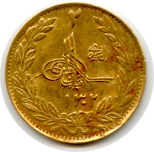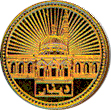 THE GOLD DINAR RESEARCH GROUP
THE GOLD DINAR RESEARCH GROUP 
|
|
|
|
Universiti
Sains Malaysia, Penang
|
About Us | Members | Activities | Articles | Photo Gallery | The Dinar | Zakat | Mahr | Dinar Trade Network| Bookshop | Links | Announcements | Contact Uss
|
|
|
|||||
|
August 20, 2002 A two-day conference on "Stable and Just Global Monetary Systems" organised by the International Islamic University opened in Kuala Lumpur. The keynote speaker was the economic advisor to the Prime Minister, Tan Sri Mohamed Yakcop, who spoke on "Trade and the Gold Dinar - the next component in the International Islamic Financial System". Below is an extract from his speech outlining how the gold dinar could play a role in international trade What is the role of the gold dinar? The proposed gold dinar will not replace the domestic currencies. The domestic currencies (e.g. ringgit) will continue to be used for domestic transactions in the respective countries. The gold dinar will be used only for external trade among the participating countries. Initially, the gold dinar will not exist in physical form. It will merely be defined in terms of gold. For example, if one gold dinar is equivalent to one ounce of gold, and the price of one ounce of gold is today at US$290, then the value of one gold dinar will be US$290 or equivalent in other currencies, on the basis of the prevailing exchange rates. The actual settlement for trade can be by way of the transfer of equivalent amount of gold. It will not be a physical transfer of gold from one country to another, but a transfer of beneficial ownership in the gold custodian's account. Where it is not possible to transfer the gold, payment can be made by way of an equivalent amount in other acceptable currencies, but this should be the exception rather than the rule. How will the gold dinar be used? The gold dinar will be used, initially, for settlement of trade on the basis of bilateral payment arrangements (BPAs). Eventually the BPAs will be converted into a multilateral payments arrangement (MPA) with the participation of as many countries as possible. The following is an illustration of how these arrangements work: Bilateral Payment Arrangement (BPA)
The important point to note here is that, under this mechanism, a relatively small amount of 0.2 million gold dinar is able to support a total trade value of 3.8 million gold dinar. In other words, we optimise on the use of foreign exchange. Even countries that do not have a large amount of foreign exchange reserves can participate significantly in international trade under this mechanism. Multilateral Payment Arrangement (VIPA)
The advantage of this refinement is that a net import position for a country during a particular quarter may be offset by a net export position in the subsequent quarter so that, for the year as a whole, the payment flows are further minimised. To summarise, we have spent a good part of the last two decades in establishing Islamic financial systems in our respective countries. I believe the time is now right to complete or complement the domestic systems with an international system - a system that will allow each Muslim country to reach out to one another and strengthen the level of trade - a system that will also allow the ummah to use its collective surpluses to fund each other, and help each other grow. Islam places great emphasis on the unity of the ummah. Given this opportunity to strengthen our relationships, using the gold dinar, I believe it is incumbent on us as a fardhu kifayah to collectively implement this next component of the International Islamic Financial System. There is a famous Chinese saying that the journey of a thousand miles begins with a first single step. I do not want to exaggerate, but if we can succeed in increasing substantially the volume of trade among the Islamic countries, the rest will follow. The promotion of direct trade between Islamic countries, preferably through the mechanism of the gold dinar, could be the initial first step in the proverbial journey of a thousand miles. |
|||||
Last Updated: 07/06/03 ©NE2002